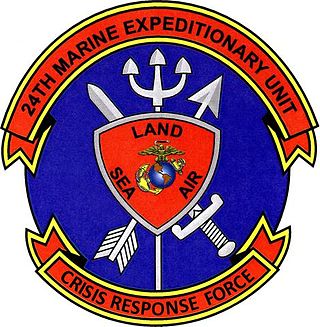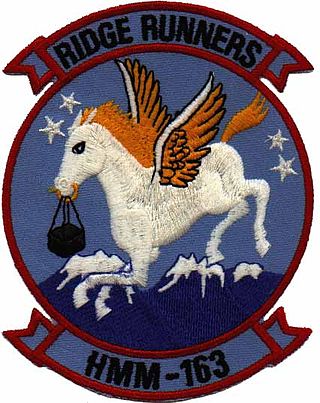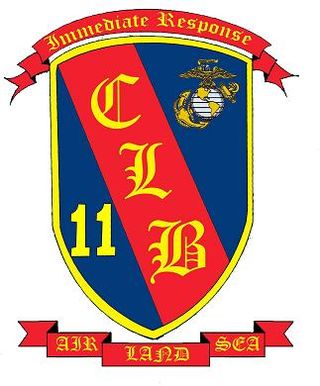Related Research Articles

USS Peleliu (LHA-5) is a Tarawa-class amphibious assault ship of the United States Navy, named for the Battle of Peleliu of World War II. Entering service in 1980, she has been deployed to the Persian Gulf on several occasions, performed an evacuation of U.S. Naval Base Subic Bay following the eruption of Mount Pinatubo, operated with the INTERFET peacekeeping taskforce, participated in Pacific Partnership deployments, and provided assistance following the massive floods in Pakistan in 2010. She was decommissioned in San Diego, California on 31 March 2015. She currently rests, out of commission and in reserve, at NAVSEA Inactive Ships On-site Maintenance Office, Pearl Harbor, Hawaii alongside USS Tarawa in the inactive reserve in case of further need.
The United States Armed Forces are the military forces of the United States. The armed forces consist of six service branches: the Army, Marine Corps, Navy, Air Force, Space Force, and Coast Guard. All six armed services are among the eight uniformed services of the United States.

USS Saipan (LHA-2) was a Tarawa-class amphibious assault ship, the second United States Navy ship named in honor of the World War II Battle of Saipan. Commissioned in 1977, the ship saw service until 2007 when she was decommissioned. In 2009 the ship was sold for scrapping.

The 2nd Marine Division is a division of the United States Marine Corps, which forms the ground combat element of the II Marine Expeditionary Force. The division is based at Marine Corps Base Camp Lejeune, North Carolina and headquartered at Julian C. Smith Hall.

2nd Battalion 5th Marines is an infantry battalion in the United States Marine Corps consisting of approximately 800 marines and sailors. They are based out of Marine Corps Base Camp Pendleton, California and fall under the command of the 5th Marine Regiment and the 1st Marine Division. The battalion has seen combat in World War I, World War II, the Korean War, the Vietnam War and the Gulf War and has deployed many times in support of Operation Iraqi Freedom and the War on Terror.

The 24th Marine Expeditionary Unit is one of seven Marine Expeditionary Units currently in existence in the United States Marine Corps. The Marine Expeditionary Unit is a Marine Air Ground Task Force (MAGTF) with a strength of about 2,200 personnel. The MEU consists of a Command Element, a Ground Combat Element based on a reinforced infantry battalion, an Aviation Combat Element based on a reinforced tiltrotor squadron, and a Logistics Command Element based on a Combat Logistics Battalion. The 24th MEU is currently based out of Marine Corps Base Camp Lejeune, North Carolina.

The 22nd Marine Expeditionary Unit is one of seven such units currently in existence in the United States Marine Corps. It is a Marine Air Ground Task Force with a strength of about 2,200 personnel. They are currently based out of Marine Corps Base Camp Lejeune, North Carolina and fall under the command of the II Marine Expeditionary Force. It is the most decorated of the U.S. Marine Corps' seven MEUs.

Marine Medium Tiltrotor Squadron 163 (VMM-163) is a United States Marine Corps helicopter squadron consisting of MV-22 Osprey transport tiltrotors. The squadron, known as "Evil Eyes", is based at Marine Corps Air Station Miramar, California and falls under the command of Marine Aircraft Group 16 (MAG-16) and the 3rd Marine Aircraft Wing.

Marine Medium Tiltrotor Squadron 264 (VMM-264) was a United States Marine Corps tiltrotor squadron consisting of MV-22 Osprey transport aircraft. The squadron, known as the "Black Knights", was based at Marine Corps Air Station New River, North Carolina, and normally fell under the command of Marine Aircraft Group 26 (MAG-26) and the 2nd Marine Aircraft Wing. They were the last east coast CH-46 Sea Knight squadron to transition to the Osprey. VMM-264 was decommissioned on 24 June 2020.

Marine Medium Tiltrotor Squadron 365 (VMM-365) is a United States Marine Corps tiltrotor squadron consisting of MV-22B Osprey transport aircraft. The squadron, known as the "Blue Knights", is based at Marine Corps Air Station New River, North Carolina and falls under the command of Marine Aircraft Group 26 (MAG-26) and the 2nd Marine Aircraft Wing.

2d Battalion, 2d Marines (2/2) is a light infantry battalion in the United States Marine Corps based out of Marine Corps Base Camp Lejeune, North Carolina. Also known as "The Warlords", it consists of approximately 1,000 marines and sailors and normally falls under the command of the 2d Marine Regiment and the 2d Marine Division.

2nd Battalion, 11th Marines (2/11) is an artillery battalion comprising four firing batteries and a Headquarters Battery. The battalion is stationed at Marine Corps Base Camp Pendleton, California. Its primary weapon system is the M777 lightweight howitzer. The battalion was the first in the Marine Corps to fully transition from the M198 Howitzer. They fall under the command of the 11th Marine Regiment and the 1st Marine Division.

The 1st Battalion, 6th Marines (1/6) is an infantry battalion in the United States Marine Corps based in Camp Lejeune, North Carolina. It consists of approximately 1,100 marines and sailors. They fall under the command of the 6th Marine Regiment, the 2nd Marine Division of the II Marine Expeditionary Force.

Marine Aircraft Group 26 (MAG-26) is a United States Marine Corps aviation unit based at Marine Corps Air Station New River composed of seven MV-22 Osprey squadrons, one of which is the Fleet Replacement Squadron, an aviation logistics squadron, and a wing support squadron. It falls under the command of the 2nd Marine Aircraft Wing and II Marine Expeditionary Force.

The 11th Marine Expeditionary Unit is one of seven Marine Expeditionary Units currently in existence in the United States Marine Corps. The Marine Expeditionary Unit is a Marine Air Ground Task Force with a strength of about 2,200 personnel. The MEU consists of a command element, a reinforced infantry battalion, a composite helicopter squadron and a logistics combat element. The 11th MEU is currently based out of Marine Corps Base Camp Pendleton, California with headquarters in Camp Del Mar.

The 15th Marine Expeditionary Unit is one of seven such units currently in existence in the United States Marine Corps. The Marine Expeditionary Unit (MEU) is a Marine Air Ground Task Force (MAGTF) with a strength of about 2,200 personnel. The MEU consists of a command element, a reinforced infantry battalion, a composite helicopter squadron and a combat logistics battalion. The 15th MEU is currently based out of Marine Corps Base Camp Pendleton, California.

The United States Marine Corps is organized within the Department of the Navy, which is led by the Secretary of the Navy (SECNAV). The most senior Marine commissioned officer is the Commandant of the Marine Corps, responsible for organizing, recruiting, training, and equipping the Marine Corps so that it is ready for operation under the command of the unified combatant commanders. The Marine Corps is organized into four principal subdivisions: Headquarters Marine Corps, the Operating Forces, the Supporting Establishment, and the Marine Forces Reserve.
The structure of the United States Navy consists of four main bodies: the Office of the Secretary of the Navy, the Office of the Chief of Naval Operations, the operating forces, and the Shore Establishment.

Combat Logistics Battalion 11 (CLB-11) is a logistics battalion of the United States Marine Corps. When not deployed they are part of Headquarters Regiment, 1st Marine Logistics Group. The unit is based out of the Marine Corps Base Camp Pendleton, California and when deployed provides combat logistical support to the 11th Marine Expeditionary Unit.

Marine expeditionary unit (special operations capable) (MEU(SOC)) is a program created by the United States Marine Corps (USMC) and the United States Navy (USN) in 1985 for Marine expeditionary units (MEU). The program enhances MEUs providing them with additional training and equipment to become certified as special operations capable with a Maritime Special Purpose Force (MSPF). The designation special operations capable is unique to the Marine Corps and means in relation to special operations. The role of a MEU(SOC) however is not equivalent to the special operations role of special operations forces. Although considered special operations capable a MEU(SOC) does not form part of the United States Special Operations Command (USSOCOM) established in 1987 or the United States Marine Forces Special Operations Command (MARSOC) later established in 2006.
References
- 1 2 "Navy Expeditionary Medal". medalsofamerica. 16 April 2013.
- ↑ "Campaign and Service Medals".
- 1 2 3 "The Marines Have Landed: Eighty Years of Marine Corps Landings, 1935–2015" (PDF). History Division: US Marine Corps.
- 1 2 3 4 Summers, Clark. "US GENOCIDE IN RWANDA 1994: A CASE STUDY IN INFORMATION OPERATIONS". USAWC WF 2303C Journal.
- 1 2 "Filling the Capability Gap". US Naval Institute.
- ↑ "Marine Corps University > Research > Marine Corps History Division > Research Tools/Facts and Figures > Chronologies of the Marine Corps > 1994". www.usmcu.edu. Retrieved 2024-05-08.